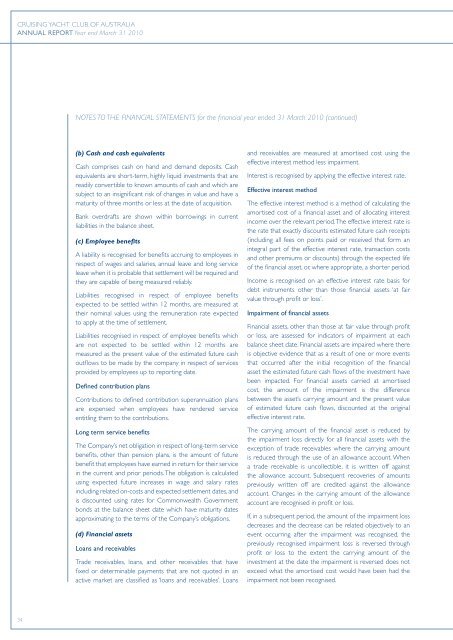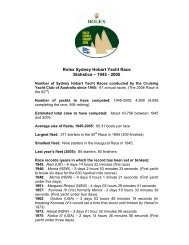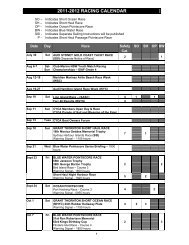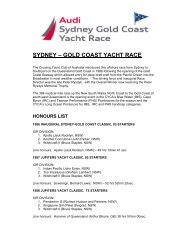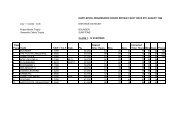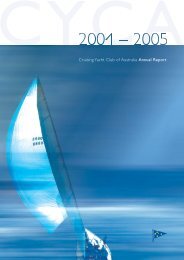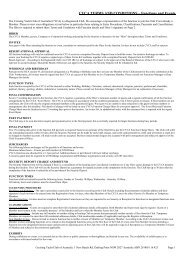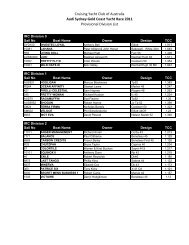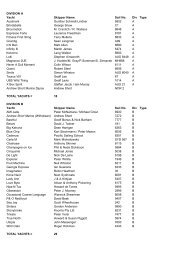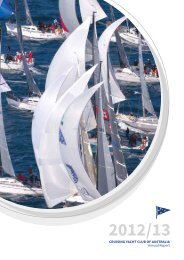2009/10 Annual Report - Cruising Yacht Club of Australia
2009/10 Annual Report - Cruising Yacht Club of Australia
2009/10 Annual Report - Cruising Yacht Club of Australia
Create successful ePaper yourself
Turn your PDF publications into a flip-book with our unique Google optimized e-Paper software.
CRUISING YACHT CLUB OF AUSTRALIAANNUAL REPORT Year end March 31 20<strong>10</strong>NOTES TO THE FINANCIAL STATEMENTS for the financial year ended 31 March 20<strong>10</strong> (continued)(b) Cash and cash equivalentsCash comprises cash on hand and demand deposits. Cashequivalents are short-term, highly liquid investments that arereadily convertible to known amounts <strong>of</strong> cash and which aresubject to an insignificant risk <strong>of</strong> changes in value and have amaturity <strong>of</strong> three months or less at the date <strong>of</strong> acquisition.Bank overdrafts are shown within borrowings in currentliabilities in the balance sheet.(c) Employee benefitsA liability is recognised for benefits accruing to employees inrespect <strong>of</strong> wages and salaries, annual leave and long serviceleave when it is probable that settlement will be required andthey are capable <strong>of</strong> being measured reliably.Liabilities recognised in respect <strong>of</strong> employee benefitsexpected to be settled within 12 months, are measured attheir nominal values using the remuneration rate expectedto apply at the time <strong>of</strong> settlement.Liabilities recognised in respect <strong>of</strong> employee benefits whichare not expected to be settled within 12 months aremeasured as the present value <strong>of</strong> the estimated future cashoutflows to be made by the company in respect <strong>of</strong> servicesprovided by employees up to reporting date.Defined contribution plansContributions to defined contribution superannuation plansare expensed when employees have rendered serviceentitling them to the contributions.Long term service benefitsThe Company’s net obligation in respect <strong>of</strong> long-term servicebenefits, other than pension plans, is the amount <strong>of</strong> futurebenefit that employees have earned in return for their servicein the current and prior periods. The obligation is calculatedusing expected future increases in wage and salary ratesincluding related on-costs and expected settlement dates, andis discounted using rates for Commonwealth Governmentbonds at the balance sheet date which have maturity datesapproximating to the terms <strong>of</strong> the Company’s obligations.(d) Financial assetsLoans and receivablesTrade receivables, loans, and other receivables that havefixed or determinable payments that are not quoted in anactive market are classified as ‘loans and receivables’. Loansand receivables are measured at amortised cost using theeffective interest method less impairment.Interest is recognised by applying the effective interest rate.Effective interest methodThe effective interest method is a method <strong>of</strong> calculating theamortised cost <strong>of</strong> a financial asset and <strong>of</strong> allocating interestincome over the relevant period. The effective interest rate isthe rate that exactly discounts estimated future cash receipts(including all fees on points paid or received that form anintegral part <strong>of</strong> the effective interest rate, transaction costsand other premiums or discounts) through the expected life<strong>of</strong> the financial asset, or, where appropriate, a shorter period.Income is recognised on an effective interest rate basis fordebt instruments other than those financial assets ‘at fairvalue through pr<strong>of</strong>it or loss’.Impairment <strong>of</strong> financial assetsFinancial assets, other than those at fair value through pr<strong>of</strong>itor loss, are assessed for indicators <strong>of</strong> impairment at eachbalance sheet date. Financial assets are impaired where thereis objective evidence that as a result <strong>of</strong> one or more eventsthat occurred after the initial recognition <strong>of</strong> the financialasset the estimated future cash flows <strong>of</strong> the investment havebeen impacted. For financial assets carried at amortisedcost, the amount <strong>of</strong> the impairment is the differencebetween the asset’s carrying amount and the present value<strong>of</strong> estimated future cash flows, discounted at the originaleffective interest rate.The carrying amount <strong>of</strong> the financial asset is reduced bythe impairment loss directly for all financial assets with theexception <strong>of</strong> trade receivables where the carrying amountis reduced through the use <strong>of</strong> an allowance account. Whena trade receivable is uncollectible, it is written <strong>of</strong>f againstthe allowance account. Subsequent recoveries <strong>of</strong> amountspreviously written <strong>of</strong>f are credited against the allowanceaccount. Changes in the carrying amount <strong>of</strong> the allowanceaccount are recognised in pr<strong>of</strong>it or loss.If, in a subsequent period, the amount <strong>of</strong> the impairment lossdecreases and the decrease can be related objectively to anevent occurring after the impairment was recognised, thepreviously recognised impairment loss is reversed throughpr<strong>of</strong>it or loss to the extent the carrying amount <strong>of</strong> theinvestment at the date the impairment is reversed does notexceed what the amortised cost would have been had theimpairment not been recognised.34


